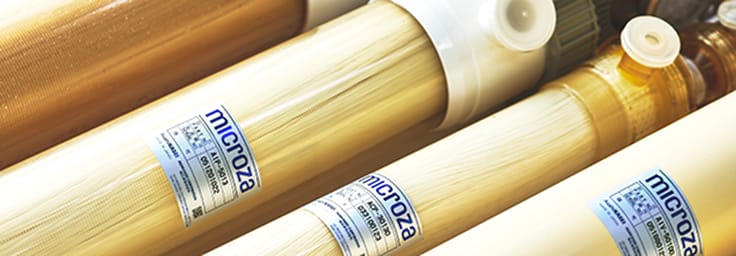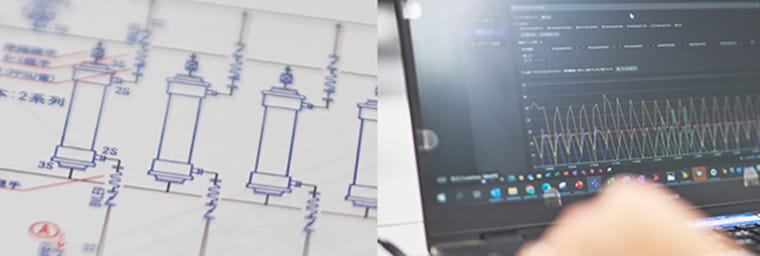A New Option for Organic Emulsion Separation
A hollow fiber membrane filtration system that accurately separates by-products and unreacted substances from chemical synthesis while maintaining high recovery rates. It supports everything from small laboratory equipment for R&D to large-scale production facilities, offering solutions that reduce costs and improve quality.
Solving Challenges with High-Precision Membrane Filtration Systems
As chemical materials become finer and more highly dispersed, it becomes difficult to efficiently filter solutions containing fine particles and by-products, making it challenging to maintain high product purity and recovery rates. Microza® cross-flow filtration technology using hollow fiber membranes can solve these issues.
-
High-Precision Separation PerformanceIt reliably separates fine particles and ionic by-products that were difficult to remove with conventional methods, enabling stable supply of high-purity products.
-
Efficient Process DesignProcess design integrating separation and recovery ensures removal of unwanted components while maximizing efficient recovery of valuable components.
-
Adaptable to Various Materials and ProcessesA wide lineup of UF and MF membranes is available, flexibly accommodating a variety of materials and processes from organic emulsions to inorganic colloidal slurries. They can be used in a broad range of fields requiring purification and concentration.
Efficient Purification and Concentration with a Single Unit
Recently, there has been a demand for efficient desalting and purification systems and compact equipment capable of both purifying and concentrating slurries in a single unit for handling organic emulsions. In addition, the need for labor-saving in production lines is increasing, and reducing manual workload caused by using multiple devices has become urgent. Specific requirements include the following.
-
Integrated Purification and Concentration ProcessIt supports not only batch processing but also continuous filtration, achieving both high purity and high recovery rates while minimizing process switching. By consolidating processes previously performed by multiple devices into a single unit, equipment installation costs and operational workload can be significantly reduced.
-
High-Strength Hollow Fiber Membranes for Stable OperationMicroza® membranes have sufficient strength to withstand relatively high operating pressures, enabling stable filtration flow over the long term through operation sequences that combine regular backwashing and cleaning.
-
Simple Processing Steps That Contribute to Labor SavingsIn gravity-based separation methods such as filter presses and candle filters, scraping and cleaning are required for slurry recovery, and there is a risk of dried slurry becoming airborne dust. In contrast, Microza® filtration systems complete processing within tanks and piping, improving the work environment while achieving labor savings and cost reduction.
Microza® provides a solution to these challenges as a cross-flow filtration system using hollow fiber membranes, enabling both purification and concentration to be completed in a single unit.
Flexible equipment design supporting scale-up and continuous operation
In the initial stages of research and development for organic emulsion processing, concentration using a centrifuge is common. However, when considering scale-up, concerns arise regarding equipment installation costs, space requirements due to larger equipment, and safe operation.
To address these challenges, Microza® utilizes UF and MF membrane technologies to provide equipment designs that can be consistently applied from research and development to mass production.
-
Smooth scale-up from research and development to mass production using the same technologyIt supports not only batch processing but also continuous filtration, achieving both high purity and high recovery rates while minimizing process switching. By consolidating processes previously performed by multiple devices into a single unit, equipment installation costs and operational workload can be significantly reduced.
-
Flexible support from batch processing to continuous processingOperation modes can be selected according to requirements. This enables both product purity and recovery rate to be achieved while optimizing the production process.
-
Module quantity can be set according to production scaleMicroza® membrane filtration systems accommodate a wide range of production capacities and processing speeds by adjusting the number of membrane modules. Stable performance is maintained even during large-scale continuous operation, allowing flexible adaptation to future production increases.
Long-term stable operation enabled by highly durable and robust membranes
In the purification and concentration of organic emulsions, conventional hollow fiber membranes are exposed to slurry abrasion and oxidizing agents over long periods, increasing the risk of membrane damage and leakage. In environments requiring repeated cleaning with chemicals containing oxidizing agents, membranes with low chemical resistance require frequent replacement and maintenance, potentially reducing production efficiency and increasing costs. With Microza®, long-term stable operation is achieved through a double-skin structure and highly durable PVDF hollow fiber membranes.
-
UF membrane module with double-skin structureConventional hollow fiber UF membranes have a single-skin structure, with the separation function present only on either the inner or outer surface. However, Microza® UF membranes feature a double-skin structure with separation functions on both surfaces, significantly reducing the risk of immediate leakage due to abrasion on the inner surface.
-
PVDF membrane module (MF membrane) manufactured by the TIPS methodMicroza® MF membrane modules use highly durable PVDF hollow fiber membranes manufactured by the thermally induced phase separation (TIPS) method. Compared to the conventional non-solvent induced phase separation (NIPS) method, they offer superior resistance to chemicals and oxidizing agents, reducing leakage risk and extending service life even in processes requiring repeated cleaning or use of oxidizers. For micron-order slurries and emulsions in chemical applications, 1.4 mmφ products are available, while 2.6 mmφ products are suitable for high-concentration applications.
-
Module quantity can be set according to production scaleMicroza® membrane filtration systems accommodate a wide range of production capacities and processing speeds by adjusting the number of membrane modules. Stable performance is maintained even during large-scale continuous operation, allowing flexible adaptation to future production increases.
Space saving, energy saving, and labor saving compared to competing technologies
Conventional filtration equipment can worsen the work environment due to equipment size, operational noise, and frequent maintenance, creating barriers to space and labor savings. For example, ceramic membranes, centrifuges, and filter presses often require large-scale installations, leading to higher initial and running costs and increased effort to maintain the work environment.
-
Comparison with ceramic membranesCompact installation enables space saving. Downsizing the circulation pump reduces energy consumption and power costs. Efficient filtration can be achieved while keeping initial costs low.
-
Comparison with centrifugesCompact installation enables space saving. Downsizing the circulation pump reduces energy consumption and power costs. Efficient filtration can be achieved while keeping initial costs low.
-
Comparison with filter pressesManual scraping and regrinding of powder are unnecessary, and operators do not need to come into contact with the actual liquid during product recovery, improving the work environment. When combined with a spray dryer, uniform particle powder can be obtained, ensuring stable yield and quality.







